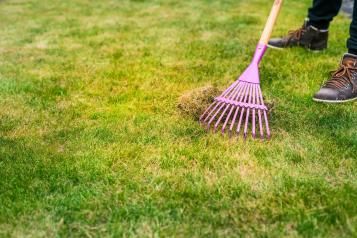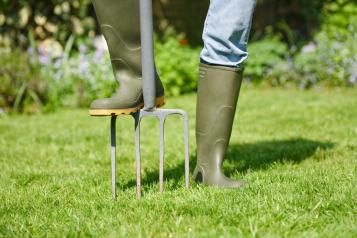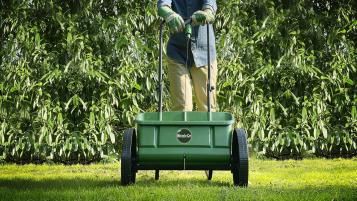
Top 7 lawn care tips
Get your lawn off to a great start in spring
A healthy lawn is the heart of a garden, giving us a place to relax, play and party with family and friends. Spring is the perfect time to give your lawn some care and attention to get it into great shape for summer. Follow our spring lawn care tips for a lush green lawn that will be the envy of all your friends!
Long, cold winters can take their toll on lawns, leaving the soil compacted and low in nutrients. As the grass starts growing in spring, it needs help to get it in shape for another summer of hard use. An annual spring lawn treatment is an effective way to look after your grass in spring and give it the conditions it needs to grow well:
- Good soil structure, enabling the grass to develop strong roots.
- Added nutrients to promote lush green growth.
- Removal of weeds and moss that compete with grass for water and food.
Develop the habit of an annual spring lawn care routine and your lawn will thank you for it!

1. Mow your lawn in spring
Once the spring grass has started to grow, it’s time to get the mower out. To avoid stressing the grass, mow your lawn with the mower on its highest setting, aiming to cut off no more than one-third of the grass blade length. Once the lawn has put on more growth you can mow on a lower setting, but keep to the one-third rule so that the grass always has plenty of leaf length left, allowing it make food through photosynthesis.
Initially you may only need to mow your lawn once a fortnight. Gradually increase the frequency of mowing as the rate of growth increases through spring and summer.
Don’t mow your lawn if the grass is wet or frozen, as this will damage the grass blades. Walking on wet lawns will also compact the soil, causing drainage problems and making it harder for grass to grow well.
2. Cut new lawn edges
Neat, well-defined lawn edges make a garden look instantly better, but over time, these edges can become a bit fuzzy and shallow. Give your lawn a spring makeover by recutting the border edges with a half-moon cutter and trimming them neatly with lawn shears.

3. Get rid of lawn weeds and moss
It’s not just the grass that starts to grow in spring – weeds do too! To get rid of lawn weeds and moss in spring, first scarify the lawn by raking over it with a spring tine rake or by using a mechanical scarifier. As well as removing moss, this gets rid of thatch, a layer of dead grass that gradually accumulates around the base of the lawn and can stop water and lawn food getting into the soil where it’s needed.
Use a lawn weedkiller on weeds like dandelions and plantains or alternatively, use a combined weed, feed and moss-killing product like Miracle-Gro Complete 4 in 1, which feeds the lawn as well as dealing with moss and weeds. Once the moss has died and turned black, it can be raked out and the bare patches can be re-seeded – check the manufacturer’s instructions on how long to wait before sowing seed in these areas.

4. Aerate your lawn
All the walking, running and general wear that happens on our lawns gradually compacts the soil. This causes poor drainage, reducing the amount of oxygen available to grass roots, and as a result the grass can struggle to grow. Aerating the soil is an excellent spring lawn treatment, helping to reduce compaction. For small lawns, you can do this with a garden fork. Simply insert the tines of the fork about 3-4 inches into the ground and then lean gently on the handle so that the ground around the tines lifts very slightly. Work your way around the garden pressing the fork into the ground at regular intervals so that you cover the whole lawn. For large lawns, use a mechanical aerator.

6. Overseed your lawn
After winter, lawns can often look rather tired and sparse. Overseeding lawns with new lawn seed in spring helps to get them looking lush and green again. Overseeding also helps to fill in bare patches caused by moss removal.
NB: If you’ve used a lawn fertiliser or a weed feed and moss killing preparation on your lawn, you may need to wait several weeks before sowing seed in these areas. Check the product packaging for more information on timings.
How to overseed a lawn in spring
- If you haven’t already mowed the lawn, do it before overseeding.
- Aerate the soil with a garden fork, hollow tine aerator or mechanical aerator to break up any compacted areas.
- Scarify the lawn with a spring tine rake or mechanical scarifier to get rid of thatch and break up the soil surface.
- Scatter lawn seed, following the manufacturer’s instructions on quantities. For even coverage over the area, scatter the seed in two passes at right angles to each other.
- Rake over the seeded area to make sure the seed is in good contact with the soil surface.
- If no rain is forecast, water daily for 4-6 weeks.

7. Apply a spring lawn feed
After a long winter, spring is an ideal time to feed your lawn to give it a boost and get it growing. Spring lawn feeds are high in nitrogen to promote lush growth, and will release their nutrients into the soil gradually over several months. To avoid burning the grass, the best time to apply spring lawn feed is just before rain is forecast and you should always follow the instructions found back of the packaging. If there’s no rain due, water the lawn thoroughly after applying fertiliser.
FAQs
When should I start mowing my lawn?
In the UK, you can usually start mowing your lawn in March or April. Mow on a high setting for the first cut, and aim to take off no more than one-third of the grass blade length. For new lawns, wait until the grass is at least 5cm tall before mowing.
When should I feed my lawn?
Feed your lawn with a high-nitrogen feed in March or April to boost it after winter and encourage lush green growth. You can apply a second feed in early summer if the lawn looks tired, but water it in well to avoid burning the grass and always follow the instructions for each product. In September, apply an autumn lawn feed high in phosphorus to promote root growth.
How should I prepare my lawn for summer?
- Mow your lawn, starting on a high setting and gradually cutting lower and more frequently as the grass starts to grow faster.
- Scarify and aerate to get rid of weeds and moss and break up compacted soil.
- Re-cut border edges.
- Overseed sparse lawns
- Apply a spring lawn feed.








